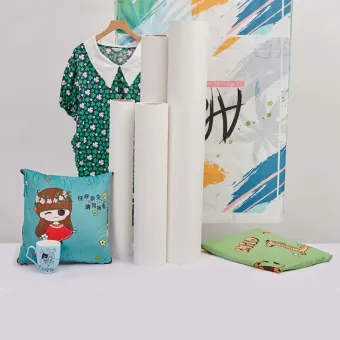Sublimation Paper vs. Heat Transfer Paper
Feb. 01, 2024
Sublimation paper and heat transfer paper are both popular methods for transferring designs onto various surfaces, particularly in the realm of fabric and garment decoration. Each method has its unique characteristics, advantages, and limitations. In this comparison, we'll delve into the differences between sublimation paper and heat transfer paper, their applications, and how they work.
1. Definition and Purpose:
- Sublimation Paper: Sublimation paper is a type of transfer paper used in sublimation printing. Sublimation printing is a process where heat is applied to transfer ink from the paper onto a substrate (usually polyester or polymer-coated surfaces). The ink undergoes a chemical process of sublimation, transforming from a solid to a gas without becoming a liquid. As it turns into a gas, it permeates the surface of the substrate, resulting in vibrant, durable, and wash-resistant prints.
- Heat Transfer Paper: Heat transfer paper is a broad term that refers to various types of transfer papers designed for transferring images onto different surfaces using heat. It includes both sublimation paper and other types, such as inkjet or laser heat transfer papers for cotton fabrics. Unlike sublimation, the ink on heat transfer paper does not undergo sublimation but rather adheres to the surface of the substrate.
2. Compatibility and Materials:
- Sublimation Paper: Sublimation paper is specifically compatible with polyester or polymer-coated substrates. It requires a high polyester content (usually above 90%) to achieve optimal results. The ink will not adhere to natural fibers like cotton since the sublimation process relies on the ink becoming a gas and infusing into the substrate rather than sitting on the surface.
- Heat Transfer Paper: Heat transfer paper comes in different types, with some suitable for cotton and other natural fibers, while others are designed for polyester, blends, or hard surfaces like ceramics and metals. For cotton fabrics, you would use inkjet or laser heat transfer papers that create a film-like layer on top of the fabric when heat is applied.
3. Printing Process:
- Sublimation Paper: Sublimation printing requires special sublimation ink, which is usually a combination of dyes. The design is printed in reverse on the sublimation paper using a compatible printer. When heat and pressure are applied through a heat press machine, the ink on the paper turns into a gas and permeates the polyester fibers, resulting in a permanent and photo-realistic print.
- Heat Transfer Paper: The process of heat transfer paper depends on the type of paper used. For inkjet or laser heat transfer papers, the design is printed on the paper using a regular printer, and then it is transferred onto the substrate using a heat press. The ink on the paper adheres to the surface of the fabric or material when heated, creating the final design.
4. Image Quality:
- Sublimation Paper: Sublimation printing produces high-quality, continuous-tone prints with smooth gradients and vibrant colors. Since the ink becomes a part of the fabric or substrate, there is no noticeable texture or feel to the print, and it retains the fabric's natural drape and breathability.
- Heat Transfer Paper: The image quality of heat transfer paper depends on the type of paper used and the substrate. Inkjet or laser heat transfer papers for cotton can produce good results, but they may not match the level of detail and vibrancy achievable with sublimation. The design can sometimes feel slightly raised or rubbery on the fabric surface.
5. Durability:
- Sublimation Paper: Sublimation prints are highly durable and wash-resistant because the ink becomes a part of the substrate. The prints do not crack, fade, or peel, making them ideal for activewear, sportswear, and items that undergo frequent washing or outdoor use.
- Heat Transfer Paper: The durability of heat transfer paper prints varies depending on the type of paper and substrate. In general, they may not be as long-lasting as sublimation prints, especially when applied to fabrics and garments that experience regular washing and wearing.
6. Application and Use-cases:
- Sublimation Paper: Sublimation printing is commonly used for personalized apparel like sports jerseys, activewear, and fashion clothing, as well as promotional items, such as mugs, phone cases, and mousepads.
- Heat Transfer Paper: Heat transfer paper is versatile and finds applications in customizing cotton t-shirts, tote bags, and other fabric items using inkjet or laser heat transfer papers. It's also used for various personalized hard goods like ceramic mugs, metal water bottles, and phone covers.
7. Limitations:
- Sublimation Paper: Sublimation printing is limited to polyester or polymer-coated substrates, which may restrict the range of materials you can work with. It is also not suitable for light-colored or dark-colored cotton fabrics.
- Heat Transfer Paper: While heat transfer paper offers more material options, the range of color vibrancy and durability may not match sublimation printing, especially when it comes to polyester substrates.
Conclusion
The choice between sublimation paper and heat transfer paper depends on the specific project requirements. If you're working with polyester-based products or substrates and prioritize vibrant and durable prints, sublimation paper is the preferred option. On the other hand, if you need to transfer designs onto cotton fabric or hard surfaces, various heat transfer papers provide more versatility. Understanding the characteristics and limitations of each method will help you make an informed decision based on your desired outcomes.
If you want to know more information about Sublimation Paper, please contact us. We will provide professional answers.
















